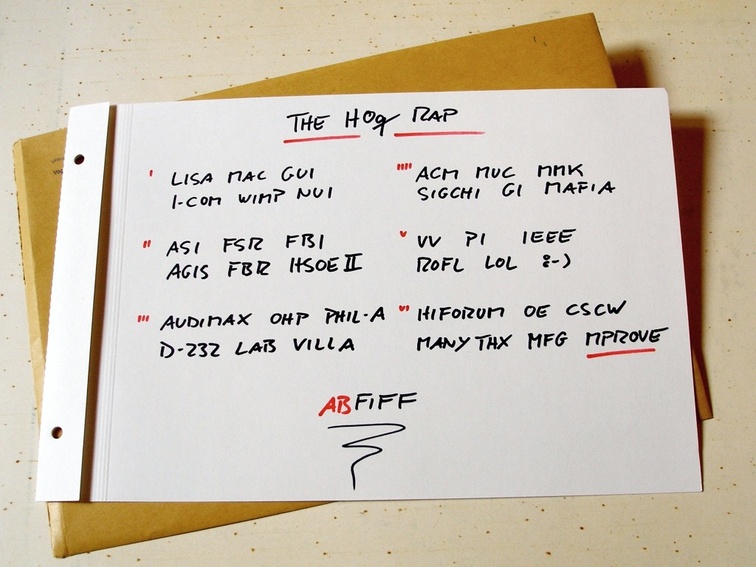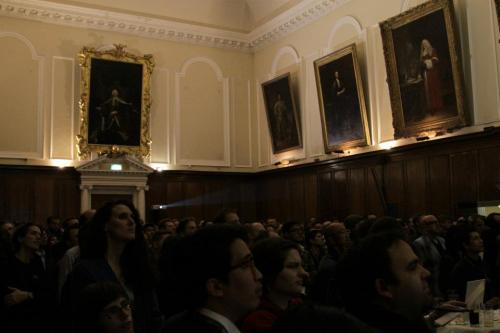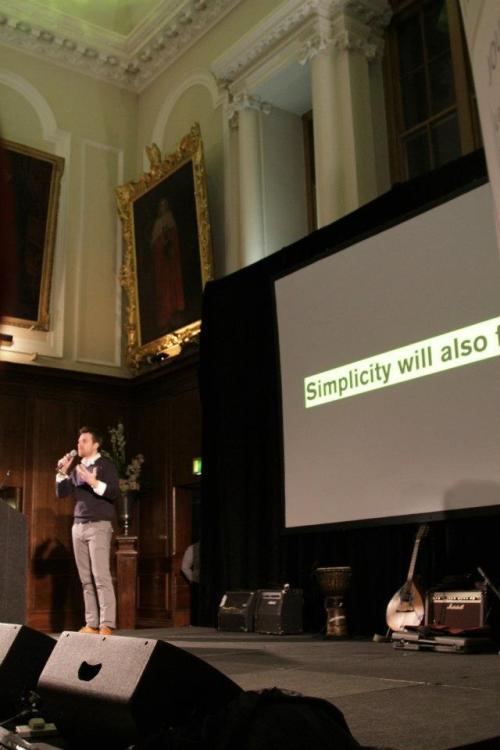Na, wer kann das alles dechiffrieren?
Month: March 2012
Understanding IA
Yet another Prezi: Understanding Information Architecture by Peter Morville_
.prezi-player { width: 550px; } .prezi-player-links { text-align: center; }
OOo History
Here is a nice info graphic on the history of the OOo universe_
.prezi-player { width: 550px; } .prezi-player-links { text-align: center; }
Sir Jonathan Ive
// Interview by Mark Prigg with Jonathan Ive, 12-Mar 2012, London Evening Standard
Sir Jonathan Ive, Jony to his friends, is arguably one of the world‘s most influential Londoners. The 45-year-old was born in Chingford — and went to the same school as David Beckham. He met his wife, Heather Pegg, while in secondary school. They married in 1987, have twin sons and now live in San Francisco. As Apple‘s Senior Vice President of Industrial Design, he is the driving force behind the firm‘s products, from the Mac computer to the iPod, iPhone and, most recently the iPad. He spoke exclusively to the Evening Standard at the firm‘s Cupertino headquarters.
Q: You recently received a Knighthood for services to design – was that a proud moment?
A: I was absolutely thrilled, and at the same time completely humbled. I am very aware that I‘m the product of growing up in England, and the tradition of designing and making, of England industrialising first. The emphasis and value on ideas and original thinking is an innate part of British culture, and in many ways, that describes the traditions of design.
Is London still an important city for design?
I left London in 1992, but I‘m there 3-4 times a year, and love visiting. It‘s a very important city, and makes a significant contribution to design, to creating something new where previously something didn‘t exist.
How does London differ from Silicon Valley?
The proximity of different creative industries and London is remarkable, and is in many ways unique. I think that has led to a very different feel to Silicon Valley.
Why did you decide to move to California?
What I enjoy about being here is there is a remarkable optimism, and an attitude to try out and explore ideas without the fear of failure. There is a very simple and practical sense that a couple of people have an idea and decide to form a company to do it. I like that very practical and straightforward approach. There‘s not a sense of looking to generate money, its about having an idea and doing it – I think that characterises this area and its focus.
What makes design different at Apple?
We struggle with the right words to describe the design process at† Apple, but it is very much about designing and prototyping and making. When you separate those, I think the final result suffers. If something is going to be better, it is new, and if it‘s new you are confronting problems and challenges you don‘t have references for. To solve and address those requires a remarkable focus. There‘s a sense of being inquisitive and optimistic, and you don‘t see those in combination very often.
How does a new product come about at Apple?
What I love about the creative process, and this may sound naive, but it is this idea that one day there is no idea, and no solution, but then the next day there is an idea. I find that incredibly exciting and conceptually actually remarkable. The nature of having ideas and creativity is incredibly inspiring. There is an idea which is solitary, fragile and tentative and doesn‘t have form. What we‘ve found here is that it then becomes a conversation, although remains very fragile. When you see the most dramatic shift is when you transition from an abstract idea to a slightly more material conversation. But when you made a 3D model, however crude, you bring form to a nebulous idea, and everything changes – the entire process shifts. It galvanises and brings focus from a broad group of people. It‘s a remarkable process.
What makes a great designer?
It is so important to be light on your feet, inquisitive and interested in being wrong. You have that† wonderful fascination with the what if questions, but you also need absolute focus and a keen insight into the context and what is important – that is really terribly important. Its about contradictions you have to navigate.
What are your goals when setting out to build a new product?
Our goals are very simple – to design and make better products. If we can‘t make something that is better, we won‘t do it.
Why has Apple‘s competition struggled to do that?
That’s quite unusual, most of our competitors are interesting in doing something different, or want to appear new – I think those are completely the wrong goals. A product has to be genuinely better. This requires real discipline, and that‘s what drives us – a sincere, genuine appetite to do something that is better. Committees just don‘t work, and it‘s not about price, schedule or a bizarre marketing goal to appear different – they are corporate goals with scant regard for people who use the product.
When did you first become aware of the importance of designers?
First time I was aware of this sense of the group of people who made something was when I first used a Mac – I‘d gone through college in the 80s using a computer and had a horrid experience. Then I discovered the mac, it was such a dramatic moment and I remember it so clearly – there was a real sense of the people who made it.
When you are coming up with product ideas such as the iPod, do you try to solve a problem?
There are different approaches – sometimes things can irritate you so you become aware of a problem, which is a very pragmatic approach and the least challenging. What is more difficult is when you are intrigued by an opportunity. That, I think, really exercises the skills of a designer. It‘s not a problem you‘re aware or, nobody has articulated a need. But you start asking questions, what if we do this, combine it with that, would that be useful? This creates opportunities that could replace entire categories of device, rather than tactically responding to an individual problem. That‘s the real challenge, and that‘s what is exciting.
Has that led to new products within Apple?
Examples are products like the iPhone, iPod and iPad. That fanatical attention to detail and coming across a problem and being determined to solve it is critically important – that defines your minute by minute, day by day experience.
How to you know consumers will want your products?
We don‘t do focus groups – that is the job of the designer. It‘s unfair to ask people who don‘t have a sense of the opportunities of tomorrow from the context of today to design.
Your team of designers is very small – is that the key to its success?
The way we work at Apple is that the complexity of these products really makes it critical to work collaboratively, with different areas of expertise. I think that‘s one of the things about my job I enjoy the most. I work with silicon designers, electronic and mechanical engineers, and I think you would struggle to determine who does what when we get together. We‘re located together, we share the same goal, have exactly the same preoccupation with making great products. One of the other things that enables this is that we‘ve been doing this together for many years – there is a collective confidence when you are facing a seemingly insurmoutable challenge, and there were multiple times on the iPhone or ipad where we have to think ëwill this work‘ we simply didn‘t have points of reference.
Is it easy to get sidetracked by tiny details on a project?
When you‘re trying to solve a problem on a new product type, you become completely focused on problems that seem a number of steps removed from the main product. That problem solving can appear a little abstract, and it is easy to lose sight of the product. I think that is where having years and years of experience gives you that confidence that if you keep pushing, you‘ll get there.
Can this obsession with detail get out of control?
It‘s incredibly time consuming, you can spent months and months and months on a tiny detail – but unless you solve that tiny problem, you can‘t solve this other, fundamental product.
You often feel there is no sense these can be solved, but you have faith. This is why these innovations are so hard – there are no points of reference.
How do you know you‘ve succeeded?
It‘s a very strange thing for a designer to say, but one of the things that really irritates me in products is when I‘m aware of designers wagging their tails in my face. Our goal is simple objects, objects that you can‘t imagine any other way. Simplicity is not the absence of clutter. Get it right, and you become closer and more focused on the object. For instance, the iPhoto app we created for the new iPad, it completely consumes you and you forget you are using an iPad.
What are the biggest challenges in constantly innovating?
For as long as we‘ve been doing this, I am still surprised how difficult it is to do this, but you know exactly when you‘re there – it can be the smallest shift, and suddenly transforms the object, without any contrivance. Some of the problem solving in the iPad is really quite remarkable, there is this danger you want to communicate this to people. I think that is a fantastic irony, how oblivious people are to the acrobatics we‘ve performed to solve a problem – but that‘s our job, and I think people know there is tremendous care behind the finished product.
Do consumers really care about good design?
One of the things we‘ve really learnt over the last 20 years is that while people would often struggle to articulate why they like something – as consumers we are incredibly discerning, we sense where has been great care in the design, and when there is cynicism and greed. It‘s one of the thing we‘ve found really encouraging.
Users have become incredibly attached, almost obsessively so, to Apple‘s products – why is this?
It sound so obvious, but I remember being shocked to use a Mac, and somehow have this sense I was having a keen awareness of the people and values of those who made it. I think that people‘s emotional connection to our products is that they sense our care, and the amount of work that has gone into creating it.
á propos:
The Shape Of Things To Come by Ian Parker, The New Yorker, Feb 2015
cyborg anthropology
I missed Amber Case’ presentation at Interaction 12 on Solid to Liquid to Air: Interaction Design and the Future of the Interface. But here it is, the webcast_
“Amber Case is a cyborg anthropologist and user experience designer who focuses on mobile software, augmented reality and data visualization, and reducing the amount of time and space it takes for people to connect. Case has been featured in Forbes, WIRED and Time, and also founded Geoloqi.com, a private location sharing application, out of a frustration with existing social protocols around text messaging and wayfinding.
Case has spoken at conferences all around the world including TED and was featured in Fast Company 2010 as one of the Most Influential Women in Technology.”
—
Other IxD12 highlights
Interaction 12 Summary
Highlights of interaction 2012 in Dublin: Day 1 / Day 2 / Day 3
Critique, aka as Feedback
And the desert: Shit Interaction Designers Say
Interaction designers are like guinea pigs
The Hamburg UX Roundtable for March was about interaction design and SCRUM. Uli and Janina presented CoreMedia‘s approach to live in cooperative co-existence between development and interaction design.
My favorite quote of the evening:
Interaktionsdesigner sind wie Meerschweinchen. Sie gehen ein, wenn man sie alleine hält. // Interaction designers are like guinea pigs. They die if you try to keep just one.
My favorite idea of the evening: serve jelly pudding in the UI color scheme of the new style guide.
Interaction 12 – Critique
I’ve summarized my highlights of Interaction 12 already on this blog: Day 1 / Day 2 / Day 3
And there are many more, hidden between the tracks. It is an open secret that the interesting stuff happens in the breaks. Meet and greet with long-time-not-seen’s, meeting virtual friends for the first time in RL, and getting in touch with other interaction designers around the world. To that extend, IxD12 was very good.
But I want to bring some light to the dark corners as well. The opening party took place at the Trinity College in the center of Dublin. A wonderful location. I’ve never been so close to the Book of Kells, but this is another story. – What do you expect from a welcome party? To be welcomed. To say Hello to friends. To talk about the first day of workshops. etc. But you I do not expect a long series of presentations on the first evening already. This was an unfortunate attempt to pick up speed and get us me into the mood for the upcoming three days. Have just a party, or do a Pecha Kuchawhen the audience is I am open to pay attention. All of the presenters would have deserved a better setting.
My second point of crit concerns the main three days of the event: It was a professional conference. Hugh? Yes, for my taste it was too slick. After all those years we are still a young profession. And that could have been better represented with a little more spontaneity, or unconference feeling. For some time I want to write about the idea of a conference experience. You can design conferences much like you can do with tools and software. Just imagine that your app runs for three days (in fact it runs much longer if you include the pre- and post-conference activities, and the twitter stream is still active with all the redux events) and that you have 700 simultaneous users. Live. It is much more like theater or circus.
Then, why do you let the Conference Center choose the music between the talks? Why do you not have some interactive game or art installations during the breaks? Why don’t you encourage (more) Q&A? The audience felt rather tired or uninspired to me. No debates at all. Hey, we do not meet that often. What was going on? Where is the energy in our field?
I should mention –my third point– that I gave up during the 10 minutes short talk sessions. I understand the idea that you want to give as much air time to as many presenters as possible. But the pulsing of 10 minutes talk – 5 minutes nothing or switching between sessions – 10 minutes high – 5 minutes low – etc. was not in synch with my bio-rhythm of attention. Now I would have appreciated the fast paced short talks from the opening party, w/o the 5 minutes breaks of course.
Dear Organizers,
please take my opinion as constructive feedback. I’ve been in your role a few times before. You’ve done a tremendous job to get all this together. But maybe future or other conferences can benefit from my impressions.
cheers, and memorizing the highlights of IxD12 once again.


